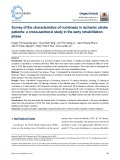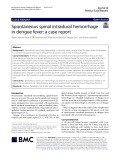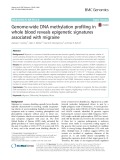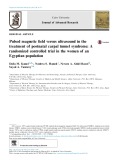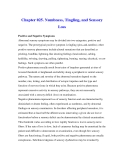
Sensory symptoms
-
Sensory disturbance is a common symptom of post-stroke. In traditional Chinese medicine (TCM), this symptom is classified as numbness (Ma Mu). While there have been many studies on the therapeutic effect of numbness in TCM, little research has been conducted on the characteristics of numbness. This study aimed to investigate the characteristics of numbness in patients with ischemic stroke in the early rehabilitation phase.
 13p
13p  viohoyo
viohoyo
 25-04-2024
25-04-2024
 3
3
 1
1
 Download
Download
-
Spontaneous spinal cord hemorrhage is extremely rare in dengue fever. We report a case of spontaneous spinal intradural hemorrhage in dengue fever associated with severe thrombocytopenia.
 4p
4p  vigamora
vigamora
 23-05-2023
23-05-2023
 4
4
 3
3
 Download
Download
-
Migraine is a common heritable neurovascular disorder typically characterised by episodic attacks of severe pulsating headache and nausea, often accompanied by visual, auditory or other sensory symptoms. Although genome-wide association studies have identified over 40 single nucleotide polymorphisms associated with migraine, there remains uncertainty about the casual genes involved in disease pathogenesis and how their function is regulated.
 10p
10p  vibeauty
vibeauty
 23-10-2021
23-10-2021
 7
7
 1
1
 Download
Download
-
The aim of this study was to compare the effects of pulsed electromagnetic field versus pulsed ultrasound in treating patients with postnatal carpal tunnel syndrome. The study was a randomized, double-blinded trial. Forty postnatal female patients with idiopathic carpal tunnel syndrome were divided randomly into two equal groups. One group received pulsed electromagnetic field, with nerve and tendon gliding exercises for the wrist, three times per week for four weeks. The other group received pulsed ultrasound and the same wrist exercises.
 9p
9p  kequaidan1
kequaidan1
 16-11-2019
16-11-2019
 12
12
 0
0
 Download
Download
-
The International Association for the Study of Pain: ‘Pain is an unpleasant sensory and emotional experience associated with actual or potential other non-painful symptoms from the same organ tissue damage, or described in terms of such or area. Chronic pain arising from the pelvic organs damage’.
 13p
13p  thaodien102
thaodien102
 06-11-2015
06-11-2015
 52
52
 3
3
 Download
Download
-
The perception of odour may result in some individuals reporting subjective sensory irritation, and individuals may perceive formaldehyde at concentrations below 0.1 mg/m3 . However, this is not considered to be an adverse health effect. The NOAEL of 0.6 mg/m3 for the eye blink response is adjusted using an assess- ment factor of 5 derived from the standard deviation of nasal pungency (sensory irritation) thresholds, leading to a value of 0.12 mg/m3 , which has been rounded down to 0.1 mg/m3 .
 0p
0p  saimatkhauroi
saimatkhauroi
 01-02-2013
01-02-2013
 55
55
 4
4
 Download
Download
-
James Parkinson described Parkinson’s disease in his memorable Essay on the Shaking Palsy in 1817. Since then, and particularly in recent years, there has been tremendous progress in our understanding of this complex and fascinating neurological disorder. Briefly, we have learned that it is not only manifest by motor symptoms but also that there is a whole range of non-motor features, including autonomic, psychiatric, cognitive and sensory impairments. We now know how to distinguish better clinically between Parkinson’s disease and the various parkinsonian syndromes.
 570p
570p  crius75
crius75
 04-01-2013
04-01-2013
 69
69
 6
6
 Download
Download
-
Not Otherwise Specified [NOS]). We also review functional brain imaging studies of patients with various forms of conversion disorder (e.g. psychogenic motor or sensory changes, psychogenic blindness, pseudoseizures) as well as depersonalization disorder. As hypnotizability traits have been postulated to be associated with a higher tendency for developing dissociative symptoms, we briefly refer to functional imaging studies of hypnosis.
 212p
212p  wawawawawa
wawawawawa
 27-07-2012
27-07-2012
 74
74
 8
8
 Download
Download
-
Positive and Negative Symptoms Abnormal sensory symptoms may be divided into two categories, positive and negative. The prototypical positive symptom is tingling (pins-and-needles); other positive sensory phenomena include altered sensations that are described as pricking, bandlike, lightning-like shooting feelings (lancinations), aching, knifelike, twisting, drawing, pulling, tightening, burning, searing, electrical, or raw feelings. Such symptoms are often painful.
 14p
14p  socolanong
socolanong
 25-04-2012
25-04-2012
 61
61
 4
4
 Download
Download
-
Gastric Motor Dysfunction Disturbed gastric motility is purported to cause acid reflux in some cases of indigestion. Delayed gastric emptying is also found in 25–50% of functional dyspeptics. The relation of these defects to symptom induction is uncertain; many studies show poor correlation between symptom severity and the degree of motor dysfunction. Impaired gastric fundus relaxation after eating may underlie selected dyspeptic symptoms like bloating, nausea, and early satiety.
 5p
5p  ongxaemnumber1
ongxaemnumber1
 29-11-2010
29-11-2010
 64
64
 2
2
 Download
Download
-
Restless Legs Syndrome (RLS) Patients with this sensory-motor disorder report an irresistible urge to move the legs, or sometimes the upper extremities, that is often associated with a creepycrawling or aching dysesthesias deep within the affected limbs. For most patients with RLS, the dysesthesias and restlessness are much worse in the evening or night compared to the daytime and frequently interfere with the ability to fall asleep. The symptoms appear with inactivity and are temporarily relieved by movement.
 5p
5p  ongxaemnumber1
ongxaemnumber1
 29-11-2010
29-11-2010
 57
57
 3
3
 Download
Download
-
Delirium: Treatment Management of delirium begins with treatment of the underlying inciting factor (e.g., patients with systemic infections should be given appropriate antibiotics and underlying electrolyte disturbances judiciously corrected). These treatments often lead to prompt resolution of delirium. Blindly targeting the symptoms of delirium pharmacologically only serves to prolong the time patients remain in the confused state and may mask important diagnostic information. Relatively simple methods of supportive care can be highly effective in treating patients with delirium.
 5p
5p  ongxaemnumber1
ongxaemnumber1
 29-11-2010
29-11-2010
 65
65
 3
3
 Download
Download
-
Harrison's Internal Medicine Chapter 25. Numbness, Tingling, and Sensory Loss Numbness, Tingling, and Sensory Loss: Introduction Normal somatic sensation reflects a continuous monitoring process, little of which reaches consciousness under ordinary conditions. By contrast, disordered sensation, particularly when experienced as painful, is alarming and dominates the sufferer's attention. Physicians should be able to recognize abnormal sensations by how they are described, know their type and likely site of origin, and understand their implications. Pain is considered separately in Chap.
 5p
5p  ongxaemnumber1
ongxaemnumber1
 29-11-2010
29-11-2010
 78
78
 3
3
 Download
Download
-
Recurrent unilateral labyrinthine dysfunction, in association with signs and symptoms of cochlear disease (progressive hearing loss and tinnitus), is usually due to Ménière's disease (Chap. 30). When auditory manifestations are absent, the term vestibular neuronitis denotes recurrent monosymptomatic vertigo. Transient ischemic attacks of the posterior cerebral circulation (vertebrobasilar insufficiency) only infrequently cause recurrent vertigo without concomitant motor, sensory, visual, cranial nerve, or cerebellar signs (Chap. 364).
 6p
6p  ongxaemnumber1
ongxaemnumber1
 29-11-2010
29-11-2010
 66
66
 6
6
 Download
Download
-
Cerebrovascular Disease Cerebrovascular disease alone rarely causes syncope but may lower the threshold for syncope in patients with other causes. The vertebrobasilar arteries, which supply brainstem structures responsible for maintaining consciousness, are usually involved when cerebrovascular disease causes or contributes to syncope. An exception is the rare patient with tight bilateral carotid stenosis and recurrent syncope, often precipitated by standing or walking.
 5p
5p  ongxaemnumber1
ongxaemnumber1
 29-11-2010
29-11-2010
 62
62
 2
2
 Download
Download
-
Shoulder Pain arising from the shoulder can on occasion mimic pain from the spine. If symptoms and signs of radiculopathy are absent, then the differential diagnosis includes mechanical shoulder pain (tendonitis, bursitis, rotator cuff tear, dislocation, adhesive capsulitis, and cuff impingement under the acromion) and referred pain (subdiaphragmatic irritation, angina, Pancoast tumor). Mechanical pain is often worse at night, associated with local shoulder tenderness and aggravated by abduction, internal rotation, or extension of the arm.
 13p
13p  ongxaemnumber1
ongxaemnumber1
 29-11-2010
29-11-2010
 88
88
 4
4
 Download
Download
-
Degenerative Conditions Lumbar spinal stenosis describes a narrowed lumbar spinal canal. Neurogenic claudication is the usual symptom, consisting of back and buttock or leg pain induced by walking or standing and relieved by sitting. Symptoms in the legs are usually bilateral. Lumbar stenosis, by itself, is frequently asymptomatic, and the correlation between the severity of symptoms and degree of stenosis of the spinal canal is poor. Unlike vascular claudication, symptoms are often provoked by standing without walking.
 5p
5p  ongxaemnumber1
ongxaemnumber1
 26-11-2010
26-11-2010
 73
73
 3
3
 Download
Download
-
Harrison's Internal Medicine Chapter 12. Pain: Pathophysiology and Management Pain: Pathophysiology and Management: Introduction The task of medicine is to preserve and restore health and to relieve suffering. Understanding pain is essential to both these goals. Because pain is universally understood as a signal of disease, it is the most common symptom that brings a patient to a physician's attention. The function of the pain sensory system is to protect the body and maintain homeostasis. It does this by detecting, localizing, and identifying tissue-damaging processes.
 5p
5p  ongxaemnumber1
ongxaemnumber1
 26-11-2010
26-11-2010
 106
106
 8
8
 Download
Download
CHỦ ĐỀ BẠN MUỐN TÌM








